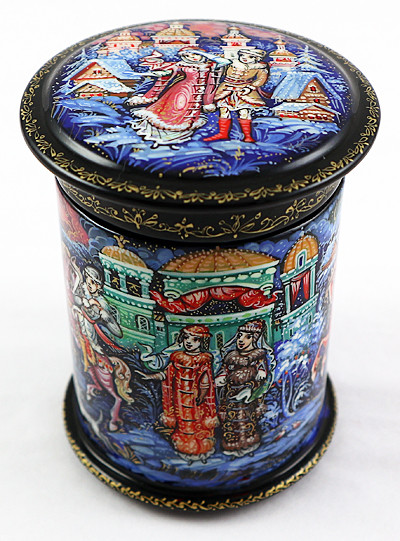Mstera (pronounced Mstiora) is a small village located a few hundred kilometers northeast of Moscow. For centuries, Mstera and the neighboring villages of Palekh and Kholui were centers for the production of icons. Most of Mstera's population was involved in some aspect of the icon painting industry. The workshops were generally run as a family business and the skills and trade were handed down from one generation to the next.
The October Revolution of 1917 brought great changes to Mstera and to Russia. Churches were closed and icon production was no longer permitted. Suddenly, the artists of Mstera were unemployed and many found it necessary to move to other regions to find work. Most Mstera residents, however, stayed and struggled to find a way to make a living.
A small group of former icon painters joined together in 1923 with the idea of creating a new, viable, industry that would employ their talents. It took a number of years to solidify their dream. Finally, in 1931 the Mstera group sent some representatives to Moscow to learn the techniques for making pâpier maché articles and also to Fedoskino to learn that village's secrets for lacquer and polishing.
With this new knowledge, the artists formed their own guild to paint lacquer miniature art on pâpier maché. The traditions of their icon painting heritage were not forgotten, merely redirected into a new form. Mstera lacquer miniature artists continued to use the egg tempera paints that they had previously employed in painting icons and the style of painting was directly influenced by Byzantine iconography. The subject matter and materials were new, but the soul and communicative power of the art remained.
The neighboring artists in Palekh had also turned to lacquer miniature painting to replace their lost jobs as icon painters. Yet, the styles of the two villages did not commingle. The Palekh artists painted in a style called "plein aire" with the sky in their landscapes left blank - the black lacquer base showing through. In Mstera, however, the artists continued painting in the sky of their lacquer miniatures just as they had in their icon painting. This was a small show of resistence against the "atheistic" regime that had forced the iconographers out of business. For the sky was a spiritual representation of the frontier - the boundary - between the celestial world and their earthly existence.
Mstera artists begin by framing the painting area with a thin line and then covering the background with a layer of white. Against the white ground additional colors appear opaque and are frequently in the pastel range (light blue, peach, ivory, pink). The landscape is of central importance to the painting with people and objects integrated to the setting. Typical themes include the fairy tales, traditional activities and events such as a winter festival, exquisite floral designs with lacy gold ornamentation, and sometimes portraiture.
With the exception of the floral motifs, gold line ornamentation is rarely used within the painting, though most Mstera lacquer boxes have at least a simple ornamental border. Mstera lacquer boxes are normally signed with gold in the margin between painting and border. They include the artist's name, village name, and frequently a title, but are rarely dated.

